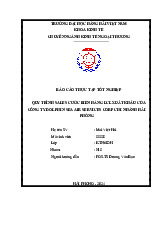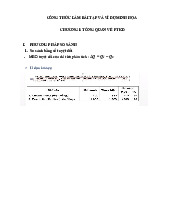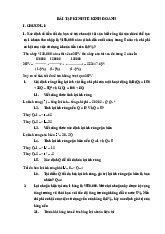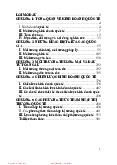
lOMoARcPSD|44862240
MoARcPSD|44862240
DOWNLOAD FULL TEST BANK FOR
INTERNATIONAL BUSINESS THE CHALLENGES OF
GLOBALIZATION 7TH EDITION BY JOHN J. WILD
AND KENNETH L. WILD
Chapter 5 International Trade
1) International trade is the purchase, sale, or exchange of goods and services across
national borders.
Answer: TRUE
AACSB: Dynamics of the global economy
Skill: Concept
Objective: 1
Difficulty: Easy
Course LO: Define the fundamental concepts of international business
2) The value of trade passing through the borders of all countries exceeds the amount of
goods and services they produce.
Answer: FALSE
AACSB: Dynamics of the global economy
Skill: Concept
Objective: 1

lOMoARcPSD|44862240
Difficulty: Moderate
Course LO: Define the fundamental concepts of international business
3) Most of the world’s merchandise trade is composed of trade in agricultural
products. Answer: FALSE
AACSB: Dynamics of the global economy
Skill: Concept
Objective: 1
Difficulty: Moderate
Course LO: Define the fundamental concepts of international business
4) Trade in services tends to be relatively more important for the world’s richest
countries. Answer: TRUE
AACSB: Dynamics of the global economy
Skill: Concept
Objective: 1
Difficulty: Easy
Course LO: Define the fundamental concepts of international business
5) When a country’s currency is weak relative to other nations, domestic products
are more expensive than imports.

lOMoARcPSD|44862240
Answer: FALSE
AACSB: Dynamics of the global economy
Skill: Concept
Objective: 1
Difficulty: Moderate
Course LO: Define the fundamental concepts of international business
6) Trade between most nations is presently characterized by a certain degree
of isolationism.
Course LO: Define the fundamental concepts of international business
7) Mercantilism states that nations should only concern themselves with
accumulating financial wealth.

lOMoARcPSD|44862240
Answer: TRUE
AACSB: Dynamics of the global economy
Skill: Concept
Objective: 2
Difficulty: Easy
Course LO: Compare and contrast theories of international trade
8) Mercantilist countries used to amass wealth by acquiring less-developed territories
around the world.
Answer: TRUE
AACSB: Dynamics of the global economy
Skill: Concept
Objective: 2
Difficulty: Easy
Course LO: Compare and contrast theories of international trade
9) Trade deficit occurs when the value of a country’s imports is greater than the value
of its exports.

lOMoARcPSD|44862240
10) Mercantilism views competition for the world’s wealth as a positive-sum game.
11) According to Adam Smith, international trade should be restricted by tariffs and
quotas in order to give a country an absolute advantage.

lOMoARcPSD|44862240
Answer: FALSE
AACSB: Dynamics of the global economy
Skill: Concept
Objective: 3
Difficulty: Moderate
Course LO: Compare and contrast theories of international trade
12) The theory of absolute advantage destroys the mercantilist idea that international
trade is a zero-sum game.

lOMoARcPSD|44862240
13) The theory of absolute advantage measures a nation’s wealth by the standard of
living of its people.
Answer: TRUE
Skill: Concept
Objective: 3
Difficulty: Easy
Course LO: Compare and contrast theories of international trade
14) Economist David Ricardo developed the theory of comparative advantage.
Answer: TRUE
Skill: Concept
Objective: 3
Difficulty: Easy
Course LO: Define the fundamental concepts of international business
15) The ability of a nation to produce a good more efficiently than any other nation is
called its comparative advantage.
Answer: FALSE
AACSB: Dynamics of the global economy
Skill: Concept

lOMoARcPSD|44862240
Objective: 3
Difficulty: Easy
Course LO: Compare and contrast theories of international trade
16) The theories of comparative advantage and absolute advantage assume that countries
are driven only by the maximization of production and consumption.
Answer: TRUE
Skill: Concept
Objective: 3
Difficulty: Moderate
Course LO: Compare and contrast theories of international trade
17) The theories of comparative and absolute advantage assume that specialization in
the production of one particular good results in efficiency gains.
Answer: FALSE
Skill: Concept
Objective: 3
Difficulty: Easy
Course LO: Compare and contrast theories of international trade

lOMoARcPSD|44862240
18) Factor proportions theory states that factors in great supply relative to demand will
be more costly than factors in short supply relative to demand.
Answer: FALSE
AACSB: Dynamics of the global economy
Skill: Concept
Objective: 4
Difficulty: Moderate
Course LO: Compare and contrast theories of international trade
19) Factor proportions theory states that a country will produce and export those goods
that require resources abundantly available within the country.
Answer: TRUE
AACSB: Dynamics of the global economy
Skill: Concept
Objective: 4
Difficulty: Easy
Course LO: Compare and contrast theories of international trade
20) The factor proportions theory of international trade was developed by Wassily
Leontief.

lOMoARcPSD|44862240
Answer: FALSE
Skill: Concept
Objective: 4
Difficulty: Easy
Course LO: Compare and contrast theories of international trade
21) In the maturing product stage of the international product life cycle theory,
production facilities are introduced in countries with the highest demand.
Answer: TRUE
AACSB: Dynamics of the global economy
Skill: Concept
Objective: 4
Difficulty: Easy
Course LO: Compare and contrast theories of international trade
22) An absolute advantage is the economic and strategic advantage gained by being the
first company to enter an industry.
Answer: FALSE
Skill: Concept
Objective: 5

lOMoARcPSD|44862240
Difficulty: Easy
Course LO: Compare and contrast theories of international trade
23) National competitive advantage theory states that a nation’s competitiveness in an
industry depends on the capacity of the industry to innovate and upgrade.
Answer: TRUE
AACSB: Dynamics of the global economy
Skill: Concept
Objective: 5
Difficulty: Easy
Course LO: Compare and contrast theories of international trade
24) According to Michael Porter, advanced factors account for the sustained competitive
advantage a country enjoys in a product.
Answer: TRUE
Skill: Concept
Objective: 5
Difficulty: Easy
Course LO: Compare and contrast theories of international trade

lOMoARcPSD|44862240
25) Companies that belong to a nation’s internationally competitive industries exist in
isolation from supporting industries.
Answer: FALSE
Skill: Concept
Objective: 5
Difficulty: Easy
Course LO: Compare and contrast theories of international trade
26) ________ refers to the purchase, sale, or exchange of goods and services across
national borders.
A) Domestic trade
B) Foreign direct investment
C) International trade
D) Mercantilism

lOMoARcPSD|44862240
Course LO: Define the fundamental concepts of international business
27) The importance of trade for a nation can be measured by ________.
A) examining the amount of wealth acquired by the national government through
restrictive trade policies
B) the living standards of people involved in only trade activities
C) the number of acquired territories the nation has that serves as sources of inexpensive
raw materials
D) examining the volume of its trade relative to its total output
AACSB: Dynamics of the global economy
Course LO: Define the fundamental concepts of international business
28) Most of the world merchandise trade is composed of trade in
________. A) minerals

lOMoARcPSD|44862240
B) services
C) manufactured goods
D) agricultural products
Answer: C
AACSB: Dynamics of the global economy
Skill: Concept
Objective: 1
Difficulty: Easy
Course LO: Define the fundamental concepts of international business
29) A majority of the total world merchandise trade occurs among ________.
A) middle-income and low-income economies
B) high-income economies
C) newly industrialized countries
D) emerging markets
AACSB: Dynamics of the global economy

lOMoARcPSD|44862240
Course LO: Define the fundamental concepts of international business
30) The smallest portion of the total world trade comprises trade between ________.
A) high-income and middle-income nations
B) low-income and middle-income
nations C) developed countries
D) First World member countries
Answer: B
AACSB: Dynamics of the global economy
Skill: Concept
Objective: 1
Difficulty: Easy
Course LO: Define the fundamental concepts of international business
31) The danger of trade dependency is that ________.

lOMoARcPSD|44862240
A) it often leads to the exploitation of developed countries
B) political turmoils in a country might affect all dependent countries
C) the countries involved in trade often get into rivalry over trade tariff issues
D) it is difficult to end trade activities with current trade partners and find new trade
partners
32) ________ says that nations should accumulate financial wealth, usually in the form of
gold, by encouraging exports and discouraging imports.
A) Absolute advantage theory
B) Factor proportions theory
C) Mercantilism

lOMoARcPSD|44862240
D) Communism
Answer: C
AACSB: Dynamics of the global economy
Skill: Concept
Objective: 2
Difficulty: Easy
Course LO: Compare and contrast theories of international trade
33) The measures of a nation’s well-being other than the financial wealth accumulated
through exports are irrelevant according to ________.
A) mercantilism
B) absolute advantage theory
C) factor proportions theory
D) new trade theory
AACSB: Dynamics of the global economy

lOMoARcPSD|44862240
Course LO: Compare and contrast theories of international trade
34) Which of the following was a prominent mercantilist
nation? A) U.S.
B) China
C) Britain
D) Japan
Course LO: Compare and contrast theories of international trade
35) One of the major pillars upon which the practice of mercantilism rested was
________.

lOMoARcPSD|44862240
A) economies of scale
B) pricing mechanism
C) excessive imports
D) trade surpluses
Course LO: Compare and contrast theories of international trade
36) The condition that results when the value of a nation’s exports is greater than the
value of its imports is called ________.
A) a trade deficit
B) a trade surplus
C) mercantilism
D) dumping

lOMoARcPSD|44862240
AACSB: Dynamics of the global economy
Course LO: Compare and contrast theories of international trade
37) The condition that results when the value of a country’s imports is greater than the
value of its exports is called ________.
A) a trade deficit
B) economies of scale
C) a break-even point
D) absolute advantage
Answer: A
AACSB: Dynamics of the global economy
Skill: Concept
Bấm Tải xuống để xem toàn bộ.




